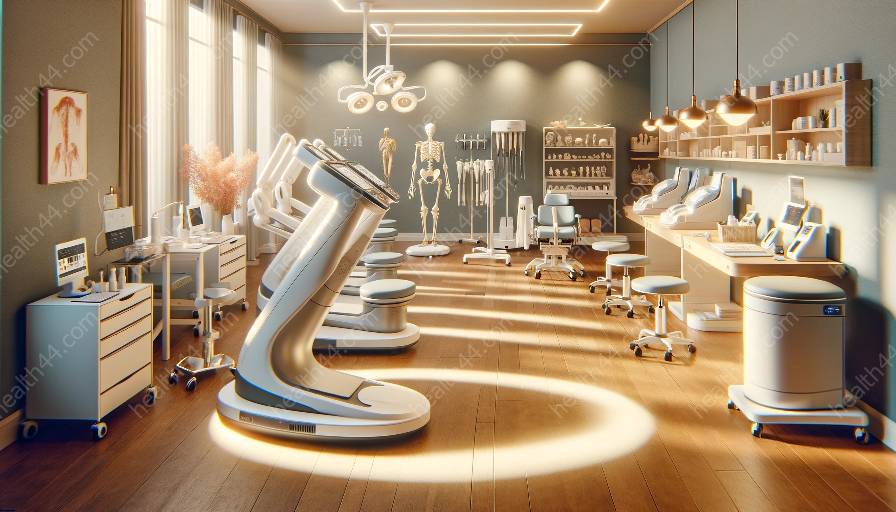Orthoses play a crucial role in orthopedic equipment and medical devices, providing support and assistance for individuals with musculoskeletal conditions. By understanding the types, functions, and benefits of orthoses, you can gain valuable insights into their significance in the field of orthopedics.
The Role of Orthoses
Orthoses, also known as orthotic devices, are externally applied devices that are designed to support, align, correct, or assist in the function of a body part. These devices are commonly used to address a wide range of musculoskeletal issues, including injuries, deformities, and post-operative support.
Within the realm of orthopedic equipment and medical devices, orthoses serve as essential tools for improving mobility, reducing pain, and enhancing overall function for individuals with various physical impairments.
Types of Orthoses
There are numerous types of orthoses, each serving specific purposes based on the individual's condition and needs. Some common types of orthoses include:
- Foot and ankle orthoses
- Knee orthoses
- Spinal orthoses
- Upper limb orthoses
- Lower limb orthoses
- Custom orthoses
These orthoses can be prefabricated or custom-made based on the patient's requirements and the recommendations of healthcare professionals, such as orthopedic surgeons, physical therapists, or orthotists.
Functions of Orthoses
Orthoses are designed to perform various functions, ultimately aiming to improve the overall musculoskeletal health and function of the wearer. Some essential functions of orthoses include:
- Providing support: Orthoses can help stabilize and support weakened or injured body parts, such as the ankle, knee, or spine, thereby reducing the risk of further injury and promoting healing.
- Alleviating pain: By offloading pressure from specific areas or providing corrective alignment, orthoses can effectively reduce pain associated with musculoskeletal conditions.
- Assisting movement: For individuals with mobility impairments or gait abnormalities, orthoses can assist in facilitating more natural and functional movement patterns.
- Preventing deformity progression: In cases of congenital or acquired deformities, orthoses can help prevent the progression of deformities and maintain proper alignment.
Benefits of Orthoses
The utilization of orthoses offers a multitude of benefits for individuals with orthopedic and musculoskeletal conditions. Some key benefits of orthoses include:
- Enhanced mobility and independence: Orthoses can enable individuals to engage in daily activities with increased mobility and independence, promoting an improved quality of life.
- Improved comfort and function: By providing support and assistance, orthoses can enhance comfort and functional abilities, allowing individuals to perform tasks with greater ease.
- Rehabilitative support: Following injuries or surgical procedures, orthoses play a vital role in rehabilitation efforts by providing necessary support and stabilization during the healing process.
- Long-term condition management: For individuals with chronic musculoskeletal conditions, orthoses serve as valuable tools in managing symptoms and preventing further complications.
Integration with Orthopedic Equipment and Medical Devices
Orthoses are closely interconnected with other orthopedic equipment and medical devices, as they often work in conjunction to address musculoskeletal conditions comprehensively. For example, orthoses can be used in conjunction with braces, assistive devices, or physical therapy equipment to maximize the benefits and outcomes for the individual.
Furthermore, advancements in technology have led to the development of innovative orthotic devices that integrate with medical equipment, such as smart orthoses with sensor technology for gait analysis or pressure monitoring.
Future Trends and Innovations
The field of orthoses is constantly evolving, with ongoing advancements and innovations aimed at enhancing the effectiveness and usability of these devices. Some emerging trends and innovations in orthoses include:
- 3D printing technology for custom orthotic solutions
- Smart orthoses with embedded sensors and connectivity for real-time monitoring
- Advanced materials for improved durability and comfort
- Personalized orthotic solutions based on biomechanical assessments and individual needs
These innovations are poised to reshape the landscape of orthotic care, offering individuals personalized and technologically advanced solutions for their musculoskeletal needs.
Conclusion
Orthoses represent a cornerstone of orthopedic equipment and medical devices, playing a pivotal role in supporting and treating musculoskeletal conditions. By understanding the diverse types, functions, benefits, and future trends of orthoses, individuals can gain a deeper appreciation for the significant impact of these devices on the well-being and mobility of patients.


